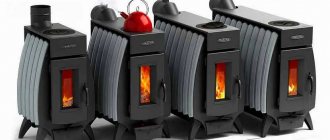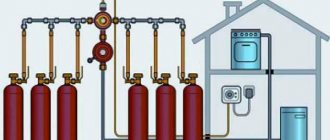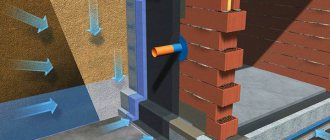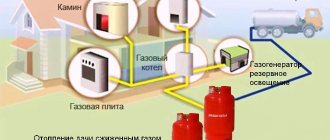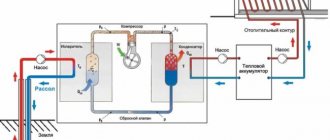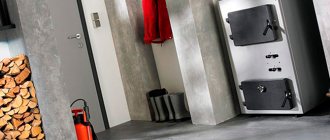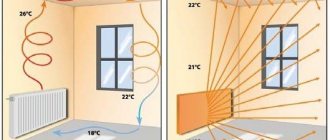The choice of heating equipment often confuses private homeowners. The hardest thing is for those who do not have practical experience in its operation. A person who has lived in an apartment since birth and then decided to build his own country house or dacha most often has no idea what is better - a stove or a boiler.
The employees of the largest heating and bathing equipment store in Novosibirsk will help us deal with this issue. The company, which will celebrate its 10th anniversary this year, supplies stoves, fireplaces, boilers and chimney systems from leading manufacturers, and the opinions of its experts are trusted by private homeowners throughout Russia.
Boiler and furnace: difference in heat transfer
One of the main differences between a furnace and a boiler is the way heat is transferred into the rooms. These features affect the rate at which rooms warm up and heat distribution.
In stove heating, the coolant is air. It heats up from the walls of the firebox and forms a convection flow. In addition, part of the heat from the stove is released in the form of infrared radiation, which is transmitted into the room. The intensity of IR rays decreases with distance from the firebox. Blank walls are an insurmountable barrier to air convection and a screen for thermal radiation. To heat a house consisting of several rooms, the stove is sometimes placed in the wall opening that separates the rooms. Some manufacturers offer models with heat sinks and flexible air ducts, through which some of the warm air can be redirected to other rooms. There are duct systems for natural and forced circulation, which are hidden in the interceiling space, but their design and implementation turn out to be expensive.
The stove begins to produce heat immediately after ignition, and the house becomes comfortable within 30 - 40 minutes.
The boiler uses water (or antifreeze) as a coolant. This makes it possible to deliver heat to the most remote corners of the house. But in order for the radiators to start giving off heat, the coolant must first warm up. Even with intense combustion, the walls of the boiler remain cold - thermal radiation from it is minimal. Depending on the power of the firebox, the initial temperature in the rooms and the volume of the heating system, warming up the rooms may take several hours.
Assembly of the structure
Assembling the radiators together is not difficult, but you should first purchase new intersection gaskets or use instead an asbestos cord impregnated with graphite powder, previously diluted in drying oil.
Since the temperature inside the boiler can exceed +600 degrees, it is worth taking care of the gaskets in advance. The tightness of the entire structure depends on their quality and strength.
The radiator assembly sequence is as follows:
- Nipples equipped with right and left threads are screwed into each section.
- Asbestos cords are wound around them.
- The sections are connected in pairs by alternately tightening the nipples. It is important to make the same number of turns with the key so as not to cause distortion.
- All sections of the cast iron radiator are connected in the same way.
- The return and supply pipes should be connected diagonally, closing unused holes with plugs.
On one side of the riser there should be a right-hand thread, and on the other, a left-hand thread. If this does not work out, then you need to screw on the nipple and the coupling with the drive on it.
Features of equipment installation
It is believed that a boiler is a compact installation compared to a furnace, and it will be much easier to put it into operation. If we are talking about a classic brick oven, then this opinion is absolutely fair. Due to the massiveness of the firebox and chimney, installation begins with the zero-cycle work, that is, with the arrangement of the foundation. It will not be easy to find a competent stove-maker: specialists have a schedule of orders scheduled months in advance, and a mason who has only been involved in general construction work is unlikely to cope with this task.
A modern metal stove is much easier to install. In most cases, it can be installed on the ceiling (in compliance with fire safety standards).
With a boiler, everything will be much more complicated, and the newer it is, the more equipment needs to be installed and connected. The list of components for a typical solid fuel system will include:
- circulation pump;
- hydraulic separator;
- buffer capacity (not mandatory, but highly desirable element);
- security group; expansion tank.
A prerequisite for installing a boiler is the presence of a separate boiler room. The stove is usually placed in the largest room by area. And here it is important that it fits into its design. Fortunately, stove manufacturers pay a lot of attention to this issue, and most modern models look aesthetically pleasing and attractive.
One of the varieties of such equipment is a fireplace stove. The closed firebox is equipped with a large viewing glass. Many models have a long burning function.
Fuel and operating modes
When choosing between a furnace and a heating boiler, factors of cost and fuel availability must be taken into account. Natural gas is undoubtedly considered the cheapest, but only if it is already supplied to the house. Otherwise, the cost of permits, work, gas heating project, equipment maintenance will be astronomical. The investment will pay off gradually over a few years.
A solid fuel boiler or stove can be installed without obtaining permits or concluding service contracts. In this case, responsibility for safe operation falls entirely on the owner of the house. The difference between them is that most metal stoves can only be heated with wood. The higher specific heat release of other types of solid fuel will cause thermally loaded areas to quickly burn out.
The boilers are distinguished by their fuel versatility. They can burn wood, coal, fuel briquettes and pellets. The water jacket surrounding the boiler firebox on all sides absorbs a large amount of heat. The metal walls do not have time to heat up to temperatures at which the metal begins to intensively oxidize.
Ovens are designed for intermittent operation unless otherwise stated in the user manual. Consultants of the Fornax online store always warn customers about this point: with continuous combustion of fuel, the metal walls of the firebox will quickly burn out.
It is better to operate the boiler in constant mode. It is started at the beginning of the heating season and stopped in the spring, when it becomes warm enough outside. It can also be used for periodic operation, but it must have an antifreeze function (and only gas and electric boilers have it), or the heating system must be filled with antifreeze. Note that many manufacturers refuse a warranty if there was anti-freeze liquid in the boiler.
Heat regulation
The presence of a buffer tank (heat accumulator) in the system plays an important role in heat absorption. This device allows you to smooth out peak heat release during intense fuel combustion. All the heat absorbed by it is returned to the heating system after the fill burns out. One of the important advantages of a boiler in conjunction with a heat accumulator is that this process can be automated. The hydraulic separator (hydraulic arrow) allows you to separate the boiler circuit from the heating circuit and supply the latter with exactly as much heat as is needed to maintain a comfortable temperature in the rooms. Of course, this causes a slight increase in the cost of the heating system.
Furnaces also have temperature control capabilities, but they are much more modest. Heat dissipation can be adjusted in much smaller ranges and only manually. Many stoves have a long-burning function, where the wood smolders for several hours. However, the subsequent filling must be burned intensively so that soot and tar deposits do not accumulate in the chimney. In any case, fuel combustion in the stove will be accompanied by temperature fluctuations in the rooms. And each stove owner will have to develop a fuel filling schedule and experimentally determine the optimal positions of the dampers. Although production models are the same, the volumetric heating value of firewood can vary greatly.
Thus, the boiler provides a more balanced microclimate in the house.
Autonomy
Unlike a completely self-contained furnace, most boilers require electricity to operate. Even models with non-volatile automation eventually turn out to be dependent on electricity: at least one circulation pump will need power. Modern gas boilers require stable and high-quality mains voltage.
A power outage, surge or drawdown will cause the boiler to “go into error”, that is, turn off the main burner and require a manual restart. The heating system will begin to cool down, and even in a well-insulated house, after 2–3 days the temperature will be equal to the street temperature. If the owners are not on site at this time, the water circuit may freeze, which will ultimately lead to large-scale repairs: replacing radiators, pipes or the heat exchanger of the boiler itself.
For trouble-free operation of heating in a house with temporary residence, you will need to organize an uninterruptible power supply system or use non-freezing liquid as a coolant. And these are additional costs. In addition, most gas boilers cannot be operated with antifreeze in CO.
Which is better: a brick stove or a boiler?
The approaching cold weather is forcing residents of Buryatia who are building a private house to quickly decide on heating their homes. And therefore, first of all, you need to carefully consider which heating will be most optimal for your home - a simple stove or boiler
The approaching cold weather is forcing residents of Buryatia who are building a private house to quickly decide on heating their homes
Of course, everyone wants it to not require large material costs and physical effort and to be warm and cozy. And therefore, first of all, you need to carefully consider which heating will be most optimal for your home - a simple stove or boiler. And if it’s a boiler, then what fuel does it use – solid, liquid, electricity or gas?
Everything will depend on the size of your home and your financial capabilities. And therefore, “Windows of Buryatia” decided to collect for our readers the opinions of people who have already encountered such a problem, and asked them to share their experience, tell what they were guided by when choosing a certain type of heating.
“There is nothing more reliable than a stove”
Stove on two floors
Ulan-Ude resident Dashima Dugarova lives in a two-story comfortable house on Zelenkhoz. The house measures 7 by 8 meters on two floors, approximately 110 square meters, and is heated by a conventional stove. The sides of the stove open into all rooms of the house. On the ground floor there is a large entrance hall, where the stove itself is located, a kitchen combined with a living room, a bathroom and a toilet. By the way, they are heated with electricity (warm floors – Note “OB”). On the second floor there are two large, bright bedrooms and a small hall.
“When my husband and I were thinking about what kind of heating to choose, we decided that nothing had yet been invented more reliable and cheaper than a simple stove,” shares the owner of the house.
They believe that in any unforeseen situations: there is no light, electricity, gas or liquid fuel prices rise, etc., the stove will never let them down. After all, we don’t have any problems with firewood in Buryatia yet.
In the most severe cold, they heat the fire twice a day: one firebox in the morning and one in the evening. The house is reliably insulated on the outside and finished with metal siding.
Over the winter, the owners burn one and a half to two cars of firewood.
Ulan-Ude residents Svetlana and Alexey Dorzhiev also maintain their position in favor of the stove. They, unlike Darima, are just building their house.
“When we were faced with the problem of choosing heating, we, after consulting with our loved ones, chose the stove,” says Alexey. “We cannot afford to build a boiler house with an expensive boiler, buy components for it, and these include pipes, radiators, an expansion tank, etc.
At first, as they say, they wanted to install steam heating from the stove. Since the house is large, with an extension it is 11 by 14 meters. But then my friends advised me to completely abandon pipes and radiators throughout the house, and install an unusual stove, which they nicknamed “Zakamenskaya”, since the stove maker is from Zakamna. It differs from a simple oven in its size. It is only 25 - 30 centimeters wide, and three meters long, and it replaces the entire main wall. The stove will heat the hallway, kitchen, living room and in one corner a large dressing room. There is no heating in two bedrooms.
— The bedroom doors will almost always be open, the heat should come from the living room from the stove. But if suddenly it gets cold in winter, then we will install additional electric convector radiators. We will turn it on as needed,” says Alexey. – And in general, we’ll see how the stove behaves, I hope we won’t freeze. The people who installed such stoves do not regret it, and the stove maker himself praised it.
Two stoves in the house
There are also those in the republic who, in the old fashioned way, install two stoves in a large house, as Damdin Erdyneev, a former resident of the Eravninsky district and now a resident of Ulan-Ude, did.
— I moved to the city a house that I built for my family back in the late 90s, it measures 14 by 12 meters. Friends laugh, they say there’s a whole gym,” Damdin shares.
According to him, he did not install any heating, but simply installed two simple stoves. He lived through one winter and does not complain about the cold.
— Of course, it takes a lot of firewood, after all, there are two stoves, but it’s still better than messing around with the boiler room. There is a lot of hassle there, taking care of the entire heating system, and you can’t turn it off in the winter cold, because everything will freeze. And you can leave the stove on at any time, and if necessary, light it,” says Erdyneev.
In the next issue we will talk about which boiler is best to choose for your home. Our readers will also share their experience and talk about the advantages and disadvantages of different boilers.
A large stove for a house measuring 8 by 9 meters requires 1000 bricks
For a medium-sized oven - 800 pieces
For a stove for a small two-story house with one firebox without a fireplace - 1200 pieces
Conclusion
It is possible to say unequivocally what is better - a stove or a boiler (solid fuel, gas or electric) only in relation to specific operating conditions. Here we can only summarize general points. It is preferable to install stoves in small buildings with irregular occupancy. They quickly warm up the room and do not require supervision after stopping. They can also be used as an additional or backup heating source.
Boilers are more often used in large houses with permanent residence. The water heating system effectively heats two-story buildings and provides good heat distribution over height. And with correctly configured circulation, the temperature in the room does not depend on its distance from the boiler room.
We recorded a video in which we clearly examined a number of important points, in our opinion, in choosing between a stove and a heating boiler. And if you still have questions, you can ask us on the official website or by phone.
FAST
SEO optimization
Adaptive layout
Repair in the regions
- home
- Articles
- Heating
- Furnace or boiler
The choice of heating equipment often confuses private homeowners. The hardest thing is for those who do not have practical experience in its operation. A person who has lived in an apartment since birth and then decided to build his own country house or dacha most often has no idea what is better - a stove or a boiler.
The employees of the largest heating and bathing equipment store in Novosibirsk will help us deal with this issue. The company, which will celebrate its 10th anniversary this year, supplies stoves, fireplaces, boilers and chimney systems from leading manufacturers, and the opinions of its experts are trusted by private homeowners throughout Russia.
